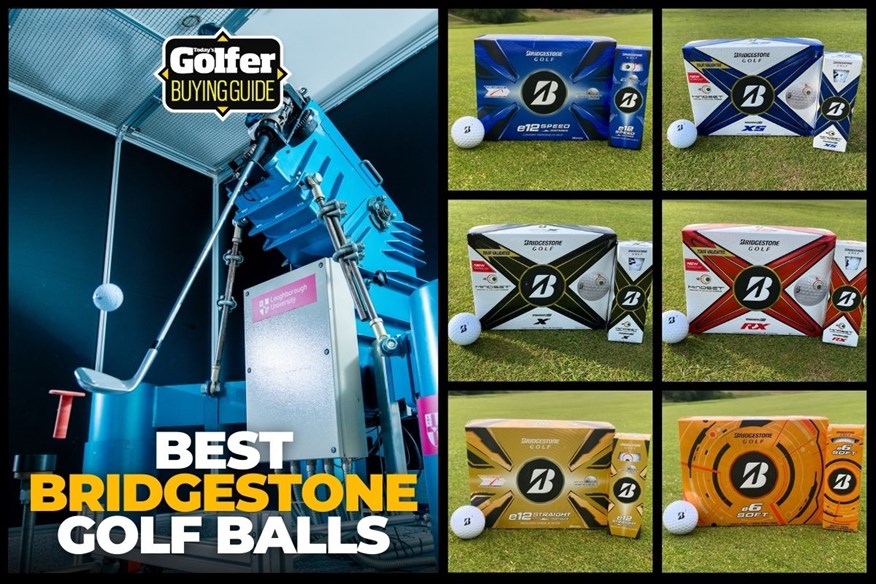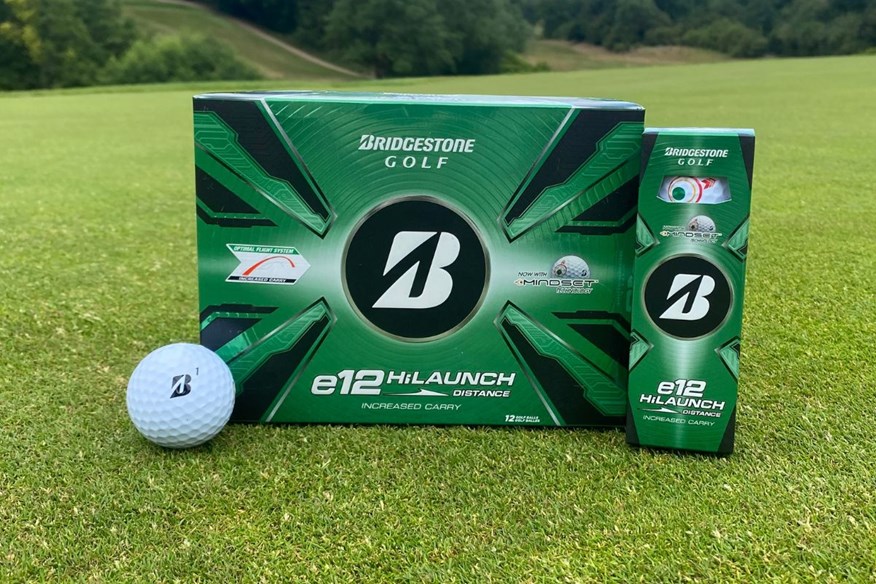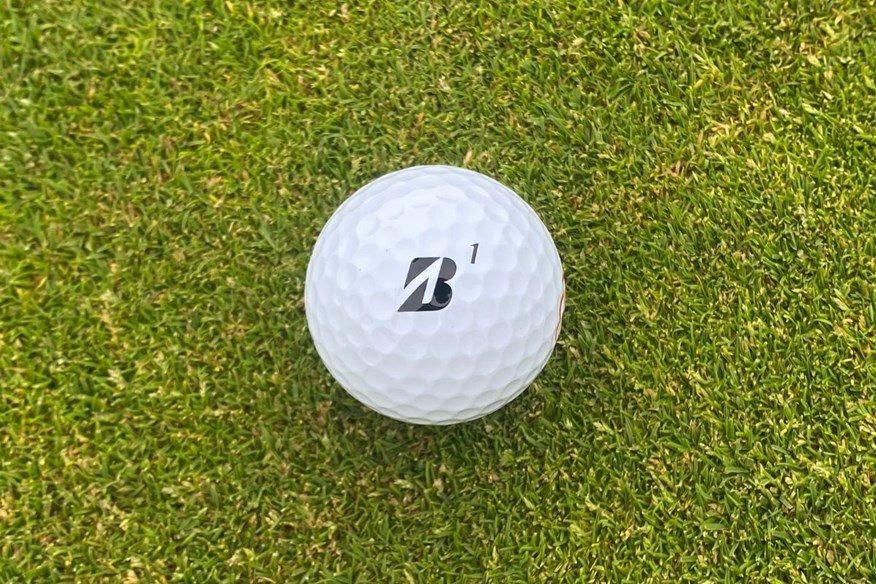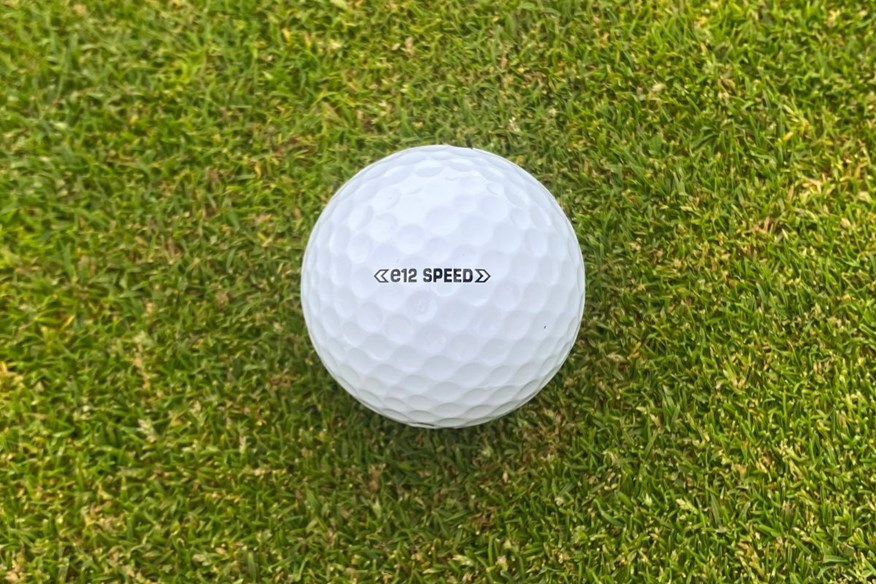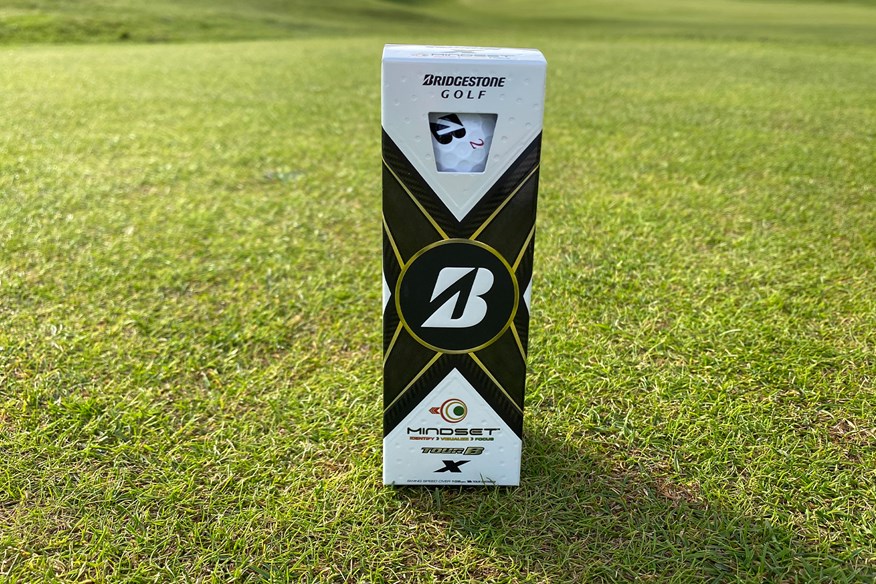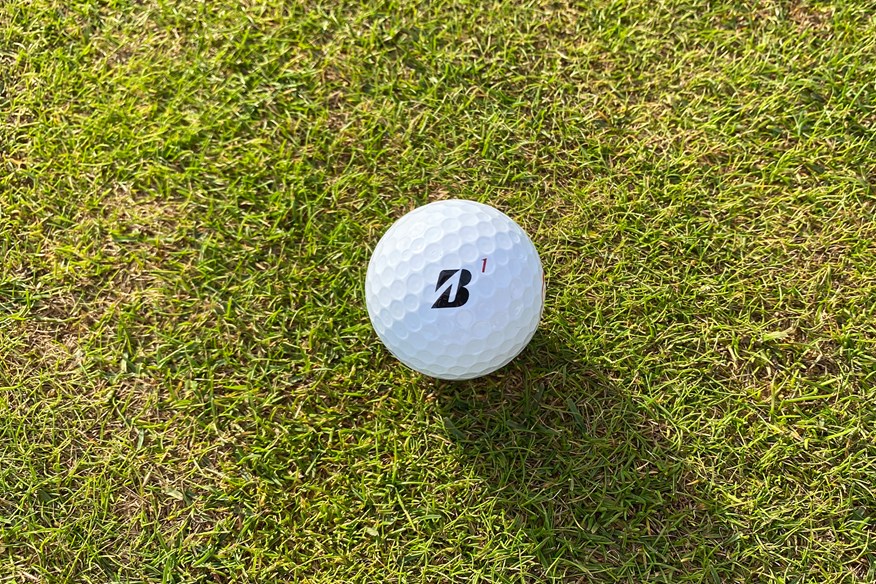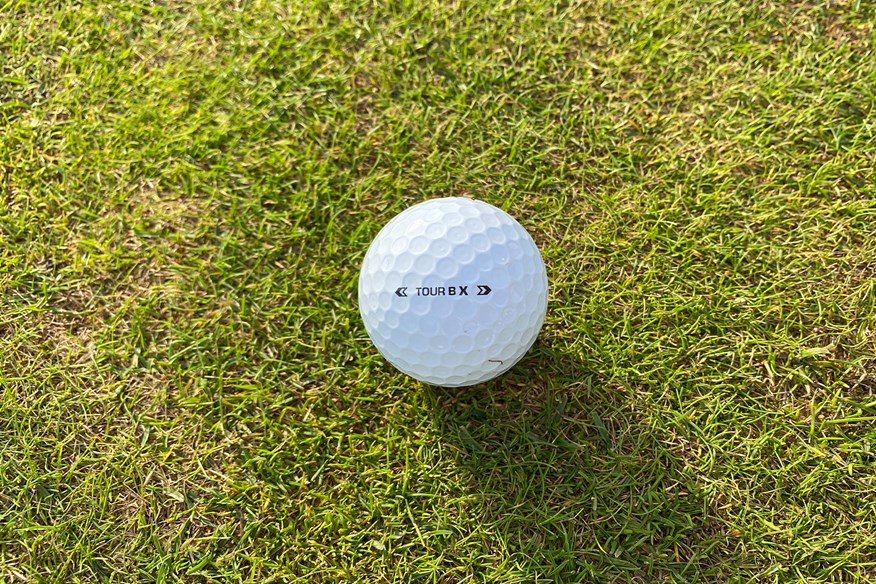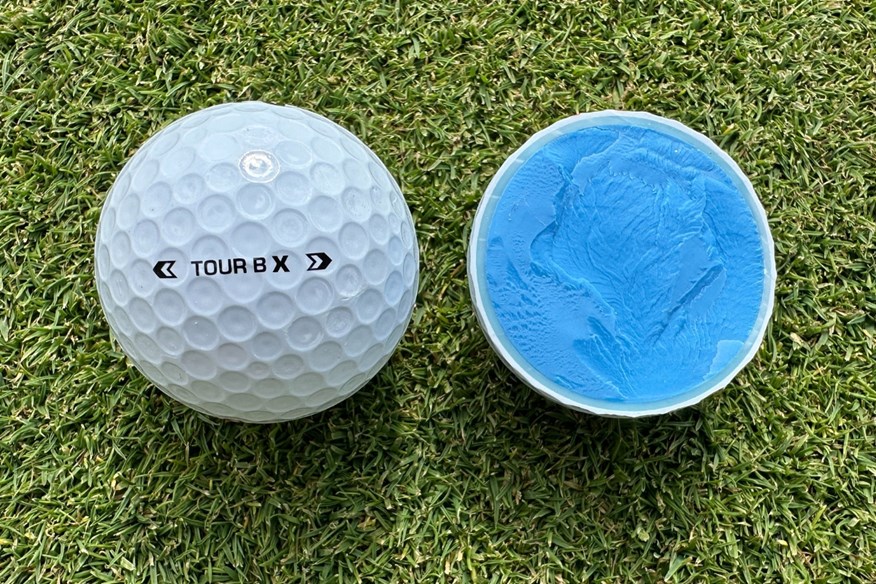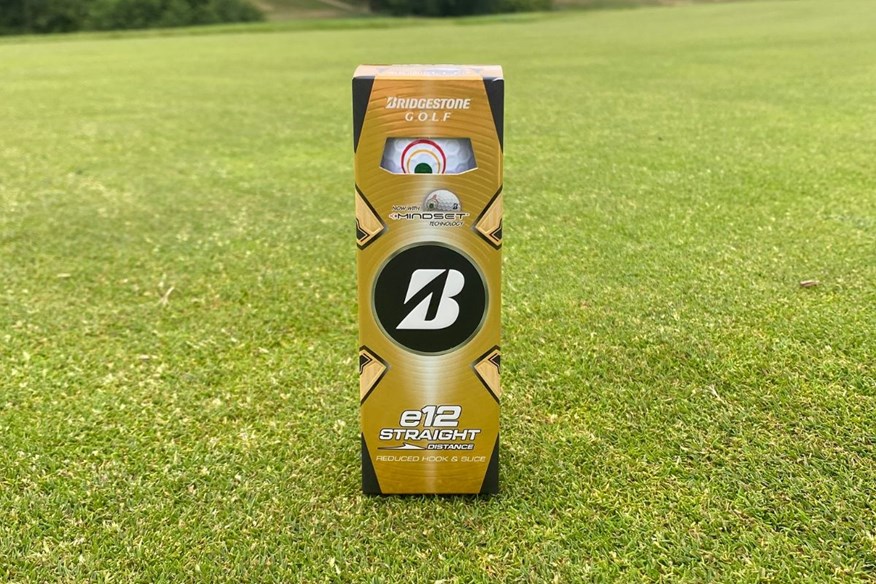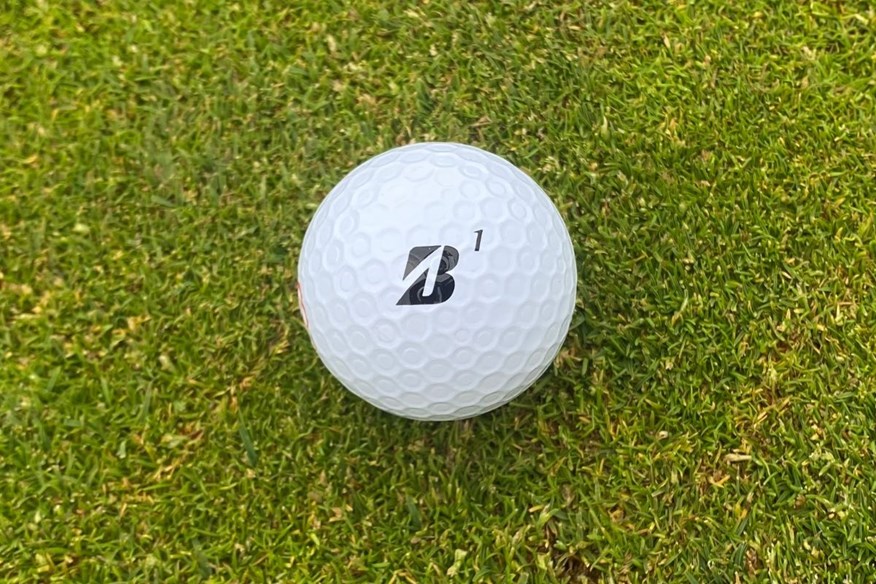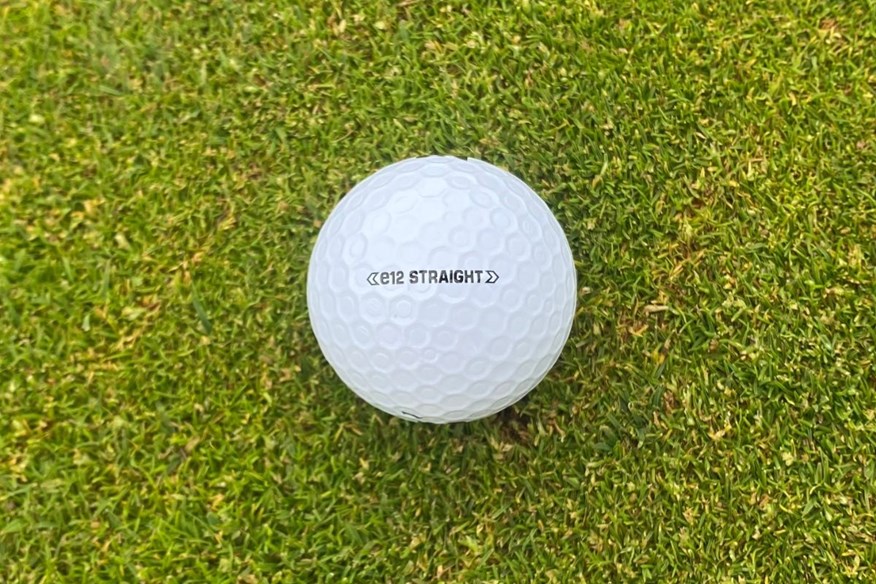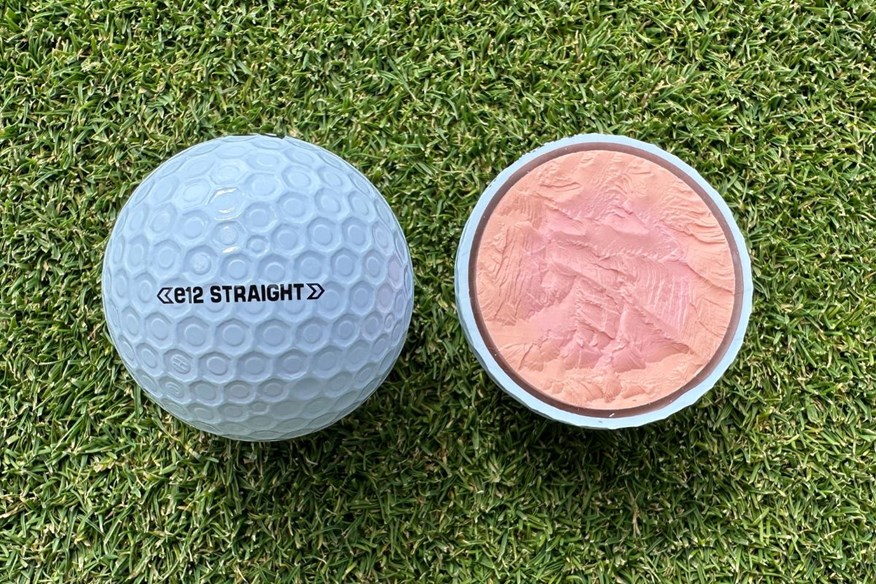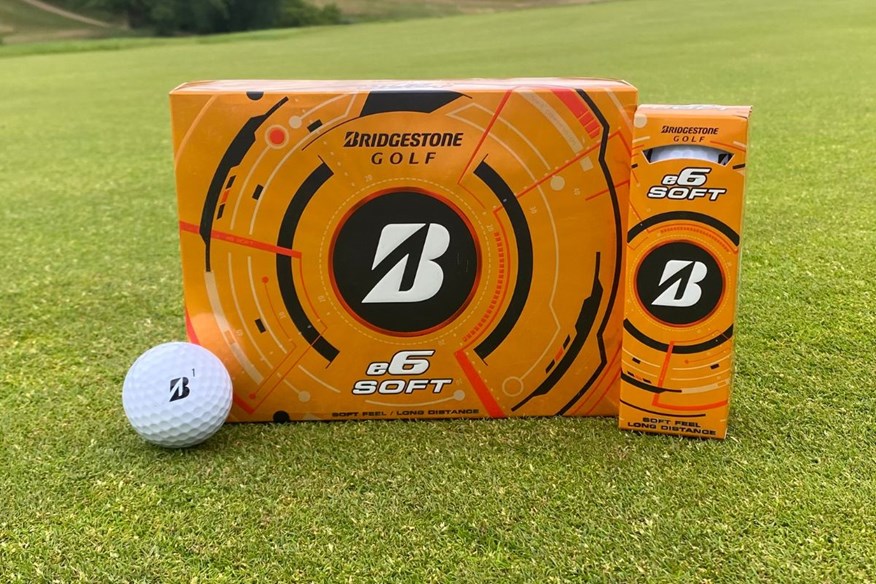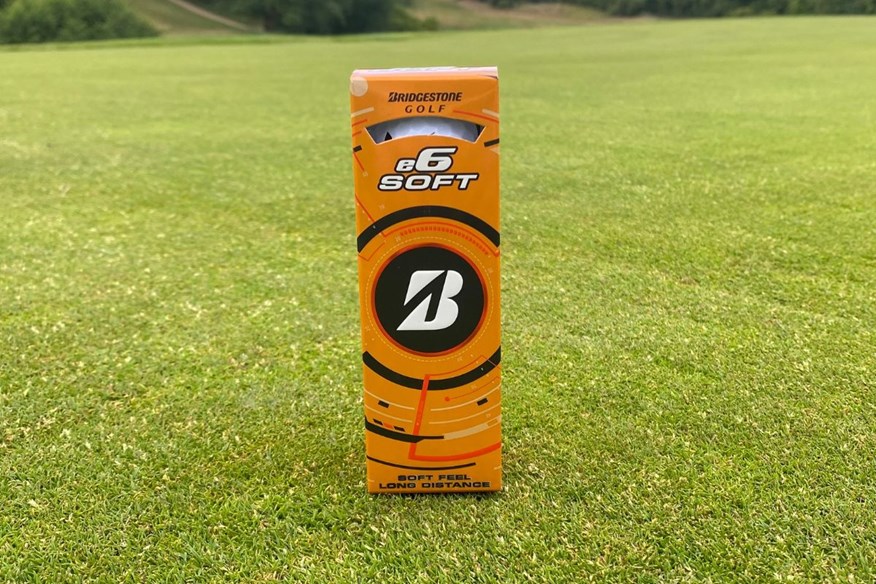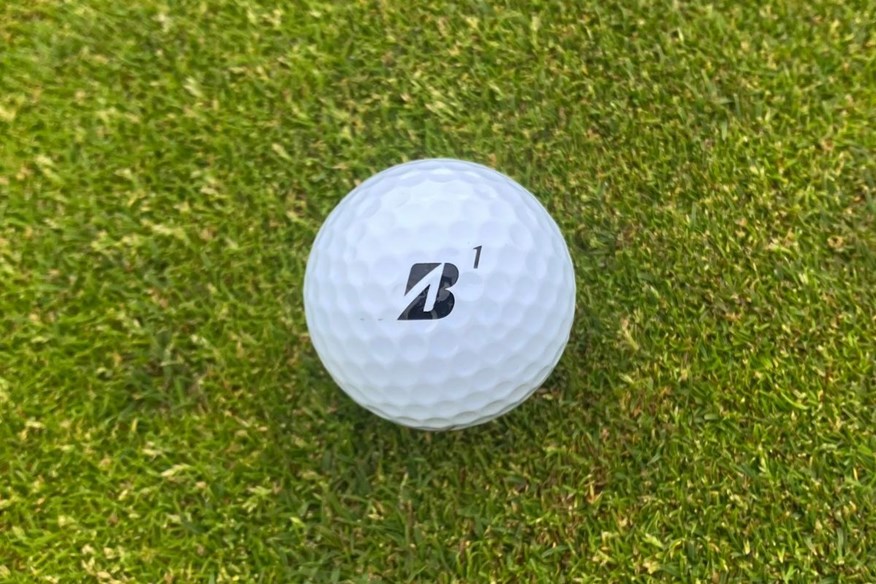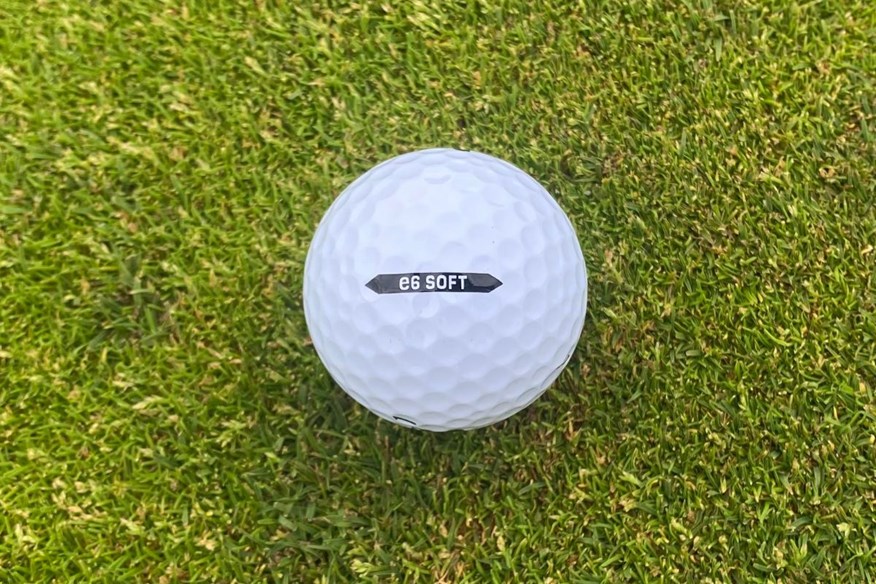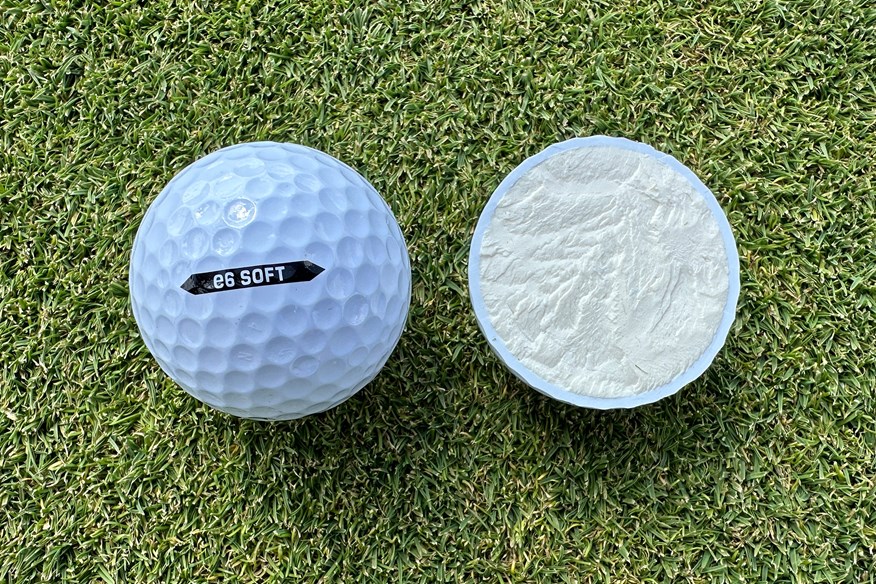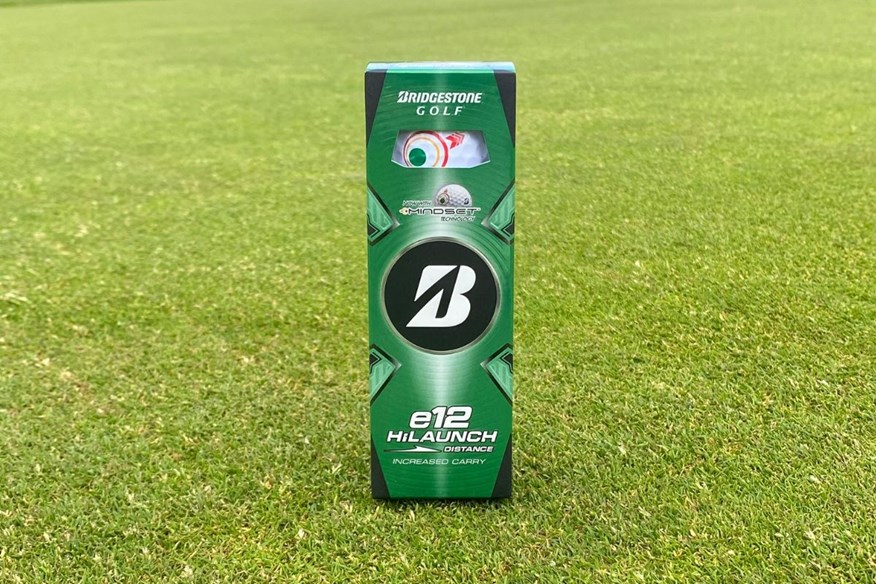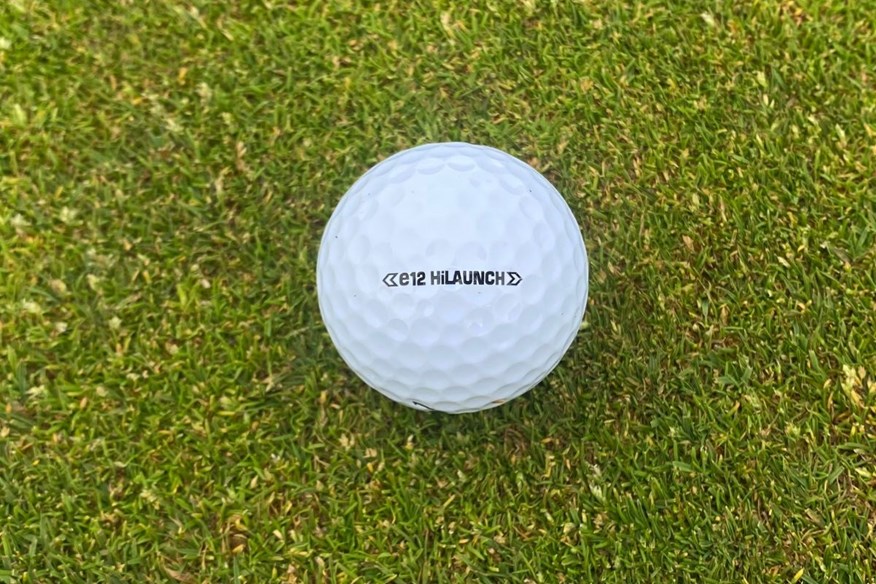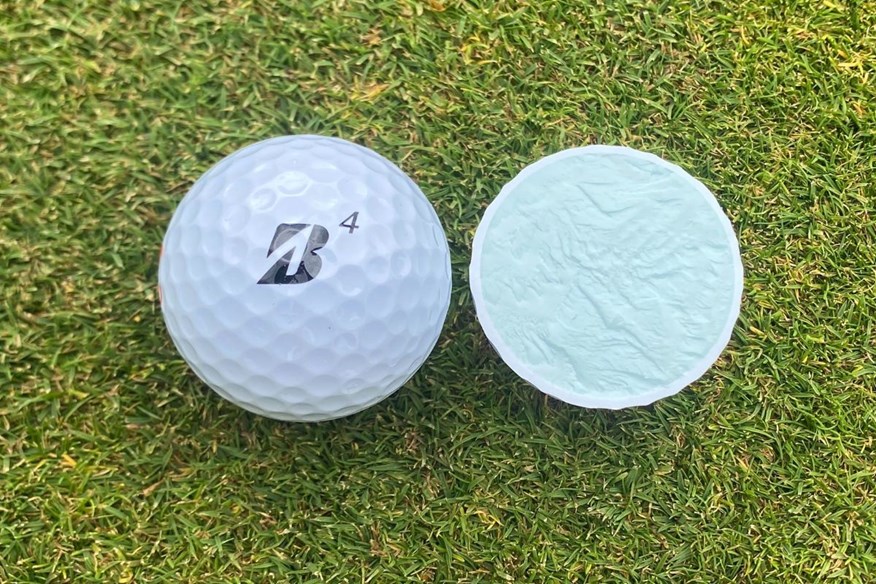Best Bridgestone golf balls 2025: Tested on an R&D robot and on-course
Last updated:
Click here to find out how we conducted our 2025 golf balls test
We’ve tested the most popular and most-played Bridgestone golf balls on an R&D robot and on-course to help you determine which is the best golf ball for your game.
Jump to:
Bridgestone are the No.1 ball fitter in golf and are responsible for some of the best golf balls on the market for golfers of all abilities. Having first produced golf balls in 1935, Bridgestone have constantly strived (and achieved) to manufacture high-quality golf balls loved by Tour players and amateur golfers.
The Georgia-based golf giants are responsible for some of the best premium golf balls played by Jason Day, Fred Couples, and 15-time major champion Tiger Woods. As well as making golf balls for some of the world’s greatest players, Bridgestone manufactures golf balls for players at the opposite end of the ability ladder. Most notably, the best two-piece golf ball.
Best Bridgestone golf balls 2025: At a glance
Best overall: Bridgestone e12 Speed | View offer
Best premium: Bridgestone Tour B XS | View offer
Firmest: Bridgestone Tour B X | View offer
Cheapest: Bridgestone e6 Soft Feel | View offer
To help you in your search for the right golf ball, we carried out our biggest ever golf ball robot test – 62 models from 13 manufacturers. As well as testing on the robot, every golf ball has been tested on-course to provide you with a personal verdict. Click the links below to see how we completed this year’s robot test and to find out exactly how we test golf equipment.
- 2025 golf ball robot test: 62 golf balls, 2,232 shots, 50,000 data points… find out what’s No.1 for you
- How we test golf equipment at Today’s Golfer
From the best value golf balls to the best high-spin golf balls, Bridgestone have models to suit every golfer’s needs and wants. One thing you are almost guaranteed from purchasing Bridgestone golf balls is quality performance at a fair price.
Bridgestone prides themselves on their research and development, which helps them deliver golf balls that push the performance capabilities to their very limits. So, let’s take a look at the best golf balls Bridgestone offers in 2025…
Best Bridgestone golf balls 2025
Gold medal for tee to green performance at all three driver swing speeds, off-the-tee performance, and approach play performance
Let's start by running through all of the e12 Speed's awards. Gold medal for tee to green performance at 114mph, 93mph, and 78mph, off-the-tee performance, and approach play performance.
The only area where the e12 Speed didn't rank is short game performance, where it finished in fourth, by 9rpm (5,951).
The e12 Speed is the highest-performing Bridgestone golf ball, factoring in how it performed in every area. Its best performance has to be off the tee. At 114mph, this golf ball was 2.4 yards longer and 0.8mph faster than the second-longest and second-fastest model, and fourth-longest overall (273.9yds).
At 93mph, the e12 Speed is the second longest (209.7yds) and fastest (134.1mph) 2-piece golf ball. But, at 78mph, this golf ball is back at the top of the table for both (161.3yds and 113.2mph).
Combine that performance with its dominating approach play performance, and not only do you have an amazing golf ball off the tee, but you have a fantastic golf ball from tee to green.
The e12 Speed is a golf ball I urge every golfer to consider. This is hands down the best value golf ball in the entire test, and as one of the best performers of all 62 models tested, what harm do you have in giving it a go?
On-course verdict
I was extremely surprised by the on-course performance of the Bridgestone e12 Speed, and having played with this golf ball on a couple of occasions, it has never disappointed.
The first time I played with the e12 Speed had me questioning if it definitely is a two-piece golf ball because it performs much closer to other three-piece Tour-level models.
The Bridgestone golf ball I' like most'm most fond of is the Tour B XS, and I think this performs very similarly - if not better.
The feel is slightly firmer than the Tour B XS, which is something I appreciate, and it does deliver more feedback and response throughout the bag.
Overall, I'm very impressed with the tee to green performance of the e12 Speed. Despite being a two-piece model, I wouldn't be quick to dismiss it.
Pros
- Perfroms more like a premium golf ball
- Outstanding tee to green performance
- Amazing feedback and response
Cons
- Very difficult to criticize
| Carry distance (yds) | Driver 114mph - 273.9 | Driver 93mph - 210 | Driver 78mph - 161.3 | 7-iron - 157.6 |
| Ball speed (mph) | Driver 114mph - 164 | Driver 93mph - 134.1 | Driver 78mph - 113.2 | 7-iron - 109.2 |
| Backspin (rpm) | Driver 114mph - 2,680 | Driver 93mph - 2,574 | Driver 78mph - 2,317 | 7-iron - 4,467 | Pitch - 5,951 |
| Launch angle (°) | Driver 114mph - 11.4 | Driver 93mph - 12.9 | Driver 78mph - 14.1 | 7-iron - 21.3 | Pitch - 30.7 |
| Descent angle (°) | Driver 114mph - 37.6 | Driver 93mph - 31.8 | Driver 78mph - 27 | 7-iron - 45.1 | Pitch - 36 |
| Peak height (yds) | Driver 114mph - 33 | Driver 93mph - 22.3 | Driver 78mph - 15.5 | 7-iron - 30 | Pitch - 6.9 |
| Compression (psi) | 103 |
- Optimal Flight System
- Fast gradational core
- MindSet technology
- 330 dimples
- 2-Piece construction
- Available in white only
Silver medal for short game performance
Best premium Bridgestone golf ball
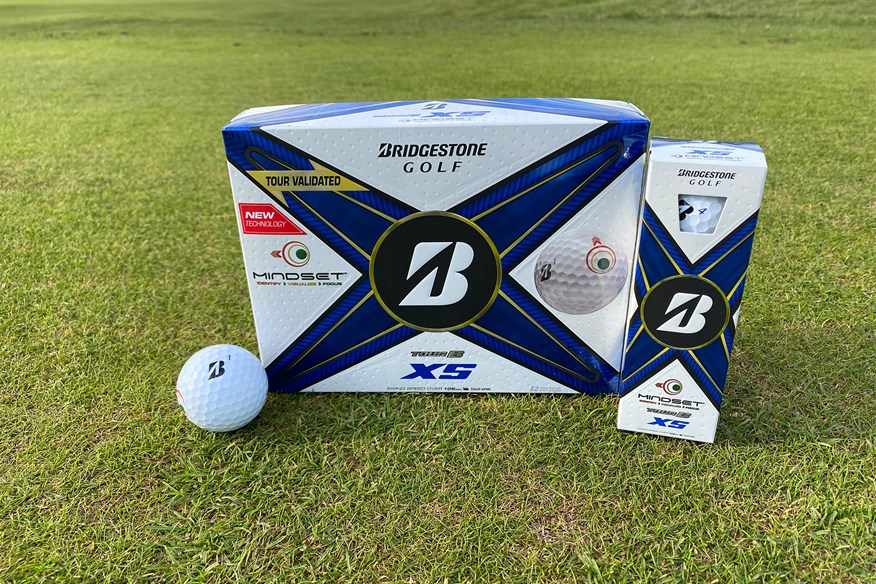

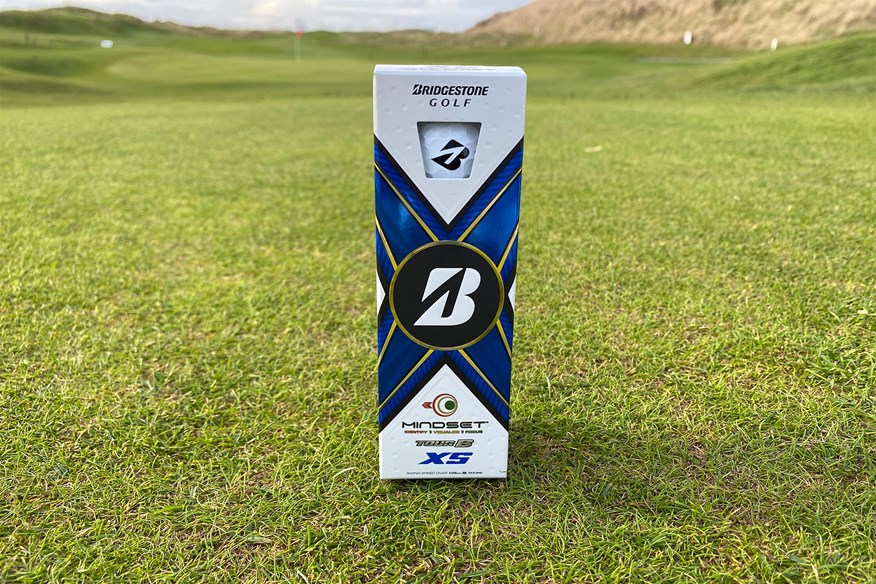
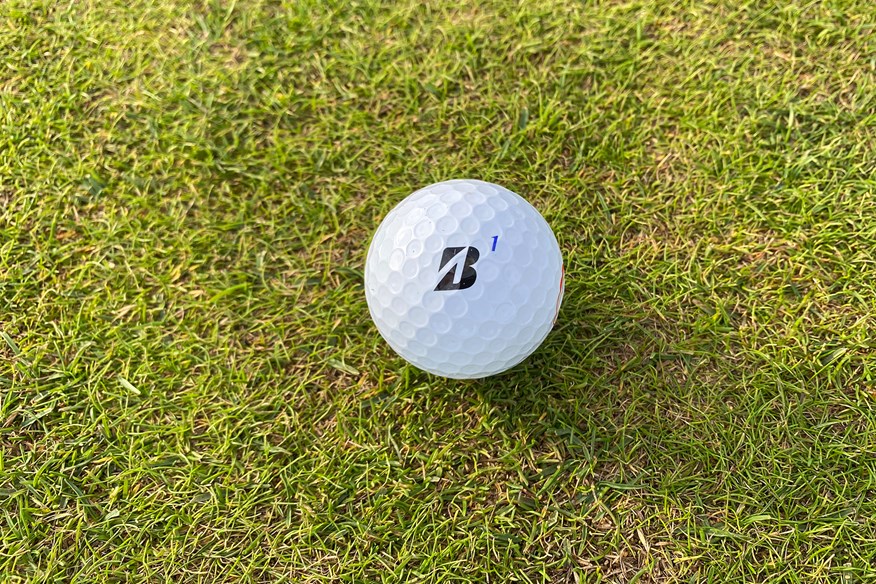
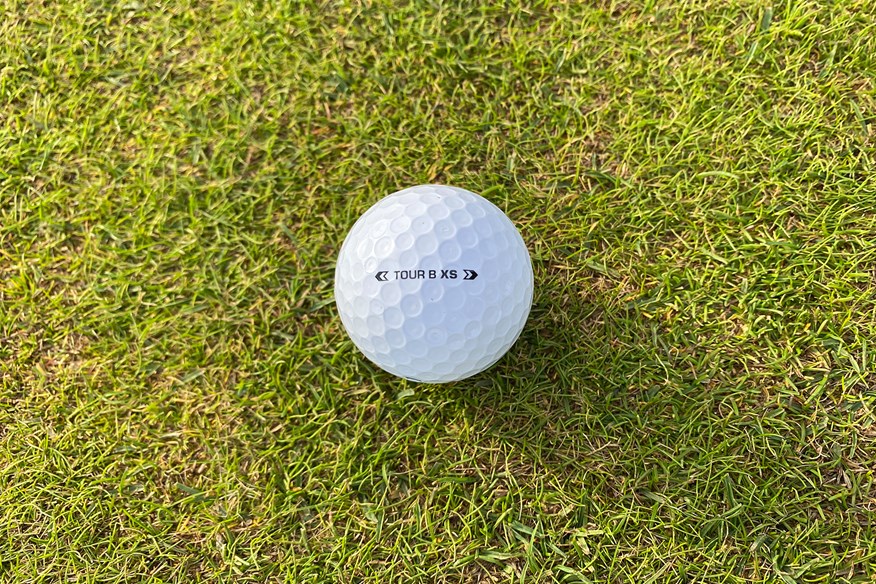
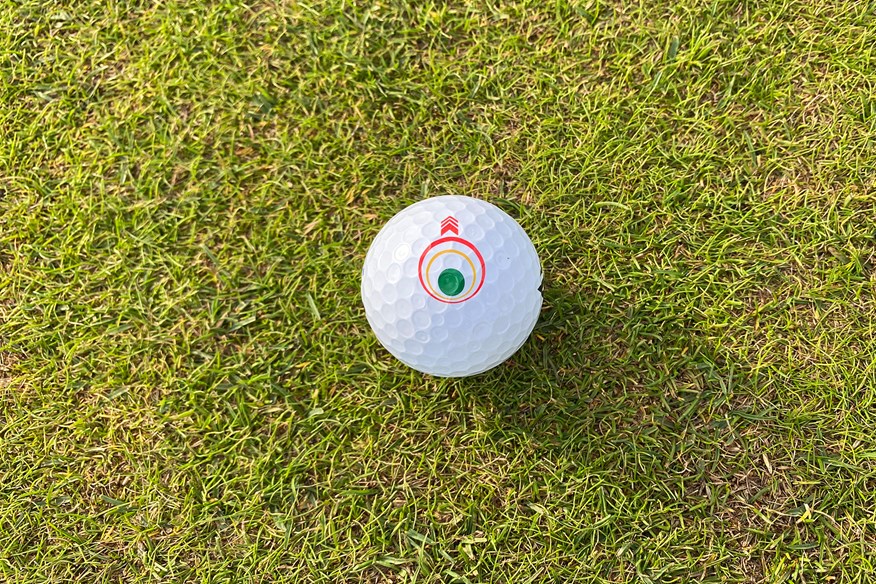
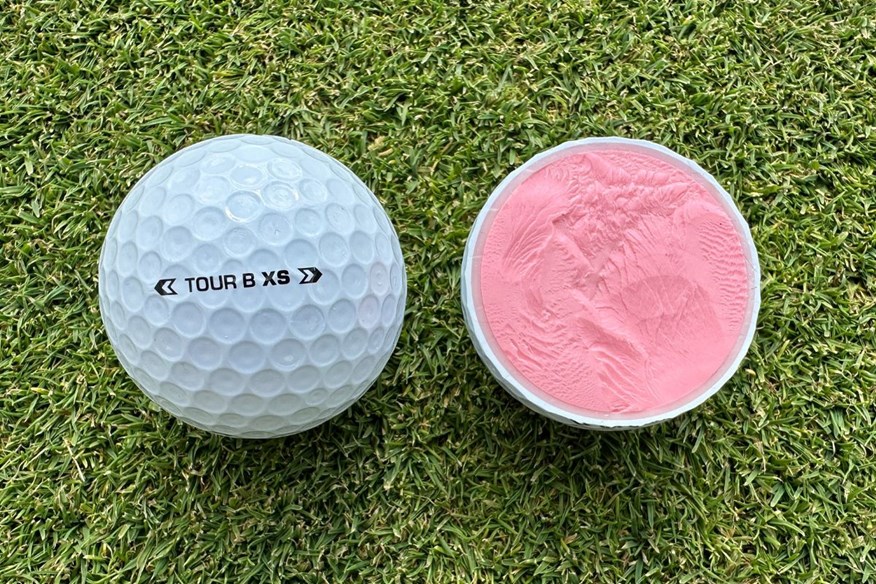
Bridgestone's Tour B XS is designed to spin higher than the Tour B X and produce a softer feeling. While our robot can't comment on the feel of this golf ball, it can tell us if it is, in fact, higher-spinning than its firmer counterpart.
Winning the silver medal for short game performance, the Tour B XS is higher-spinning around the greens than the Tour B X (6,036rpm vs. 5,972rpm). It's not drastically higher spinning, but you can expect more grab and control.
That transfers into approach play. Within the three-piece Tour-level category, the Tour B XS is the highest-spinning golf ball with over 5,000 rpm - one of only two (5,170). It's also the second-highest-spinning golf ball in the entire test.
Unfortunately, due to the dominance of the Z-Star range, the Tour B XS just misses out on a podium place for approach play performance.
Off the tee, the high-spinning nature of the Tour B XS really hurts its overall performance. At all three driver swing speeds, it ranks low, being the highest-spinning model at 78mph (second overall) and 93mph (first overall), and the second-highest-spinning golf ball at 114mph (third overall).
There'll be a lot of people put off by how much the Tour B XS spins, and it's a big reason why Tiger Woods switched to the Tour B X. However, if you struggle to generate spin, the Tour B XS is a golf ball you should definitely consider. I love it for that exact reason, and while it might not go as far off the tee, it makes up for the reduced distance by offering amazing spin and control.
On-course verdict
The Tour B XS isn’t a model found on Tour; the Tour B X is a much more popular model among the pros. For a golfer who’s looking for a soft-feeling golf ball that easily generates spin and has a driver swing speed north of 105mph, the Tour B XS is definitely a model to consider.
Some golf balls are able to work for a wide range of golfers. However, I wouldn’t say that’s the case with the Tour B XS.
As a golfer who needs help adding spin and height off the tee, the Tour B XS is a brilliant golf ball for me. I feel as though from tee to green, this ball performs incredibly well and delivers everything I need and want from a golf ball.
The Tour B XS is a soft-feeling golf ball, which I’m not normally a fan of, but I am with the Tour B XS because it’s very responsive. I think you get a lot of feedback from every shot you play with the Tour B XS.
Read our full Bridgestone Tour B XS golf ball review.
Pros
- Incredible feel and response from every shot
- Amazing spin and control around the green
- Mindset is a brilliant tool
Cons
- Not the most versatile model
| Carry distance (yds) | Driver 114mph - 268.4 | Driver 93mph - 206.7 | Driver 78mph - 160.5 | 7-iron - 153.5 |
| Ball speed (mph) | Driver 114mph - 162.7 | Driver 93mph - 133.6 | Driver 78mph - 112.8 | 7-iron - 109 |
| Backspin (rpm) | Driver 114mph - 2,964 | Driver 93mph - 3,059 | Driver 78mph - 2,795 | 7-iron - 5,170 | Pitch - 6,036 |
| Launch angle (°) | Driver 114mph - 11 | Driver 93mph - 12.3 | Driver 78mph - 13.7 | 7-iron - 20.3 | Pitch - 30 |
| Descent angle (°) | Driver 114mph - 38.6 | Driver 93mph - 33.6 | Driver 78mph - 28.4 | 7-iron - 45.2 | Pitch - 35.3 |
| Peak height (yds) | Driver 114mph - 33.1 | Driver 93mph - 22.8 | Driver 78mph - 15.8 | 7-iron - 29.1 | Pitch - 6.7 |
| Compression (psi) | 99 |
- REACTIV X System
- REACTIV iQ Smart Cover Technology
- XCLRNT mid-layer
- Gradational Core
- Dual Dimple
- Seamless Cover
- 330 dimples
- 3-Piece construction
- Available in white and yellow
- An alternative model is the Mindset
Bronze for short game performance
The Tour B X is Bridgestone's most popular model on Tour. It's the highest compression Tour B golf ball, and it's built to offer a firm feel and distance over spin. But that doesn't mean it produces low spin.
The Tour B X is the third-best 3-piece Tour-level golf ball for short game performance (5,972rpm), only behind the Z-Star Diamond and higher-spinning Tour B XS.
Despite being Bridgestone's most popular model among Tour players, the Tour B X is the lowest-performing golf ball in this category off the tee at 114mph, delivering the lowest ball speed (160.4mph), 1.5mph slower than the second slowest model. It's also the shortest (268.3yds).
At 93mph, it's much more competitive, but again, at 78mph, performance drops, and it's back towards the bottom of the leaderboard.
With approach play, the Tour B X is slightly above the test average, generating 4,787rpm backspin and 45.1° descent angle. While this might be a low-spin golf ball in the Tour B X family, it's not up against other brands' models.
The Tour B X performed best in an area we weren't expecting, and it just happens to be an area where the Tour B XS is better. However, with more Tour approval than the Tour B XS, it's hard to completely discount this golf ball, although it wouldn't be my first choice.
On-course verdict
I could easily game the Tour B X from a feel and short-game spin and control perspective, but the reason I can’t justify putting this ball in play is that it launches too low and doesn’t spin enough off the tee.
The Tour B X is a firmer-feeling golf ball than the Tour B XS, which means it feels more solid off the club face. A firm-feeling golf ball isn’t to everyone’s taste, but I wouldn’t go as far as to say this is a firm golf ball, just a firmer-than-soft model.
Whether you’re smashing a drive or trickling in a difficult putt, the response from the Tour B X, throughout the bag, is highly satisfying.
The tee to green performance is close to perfection. If I’m nitpicking, they don’t spin high enough with scoring clubs. However, that might be perfect for your game. They probably aren’t as versatile as the Tour B XS because they’re harder to launch, but they feel good off every club face and deliver amazing performance, especially off the tee.
Read our full Bridgestone Tour B X golf ball review.
Pros
- Firmer-feeling and highly responsive
- Penetrating and straight ball flight
- Impressive control around the green
Cons
- Urethane cover quality wasn't consistent
| Carry distance (yds) | Driver 114mph - 268.3 | Driver 93mph - 208.7 | Driver 78mph - 160.5 | 7-iron - 155.2 |
| Ball speed (mph) | Driver 114mph - 160.4 | Driver 93mph - 134 | Driver 78mph - 112.8 | 7-iron - 108.9 |
| Backspin (rpm) | Driver 114mph - 2,605 | Driver 93mph - 2,810 | Driver 78mph - 2,512 | 7-iron - 4,787 | Pitch - 5,972 |
| Launch angle (°) | Driver 114mph - 12.1 | Driver 93mph - 12.7 | Driver 78mph - 13.9 | 7-iron - 20.8 | Pitch - 30.3 |
| Descent angle (°) | Driver 114mph - 37.5 | Driver 93mph - 32.8 | Driver 78mph - 27.5 | 7-iron - 45.1 | Pitch - 35.5 |
| Peak height (yds) | Driver 114mph - 32.8 | Driver 93mph - 22.7 | Driver 78mph - 15.5 | 7-iron - 29.4 | Pitch - 6.6 |
| Compression (psi) | 112 |
- REACTIV X System
- REACTIV iQ Smart Cover Technology
- XCLRNT mid-layer
- Gradational Core
- Dual Dimple
- Seamless Cover
- 330 dimples
- 3-Piece construction
- Available in white and yellow
- An alternative model is the Mindset
Bridgestone's longest 3-piece golf ball
Longest three-piece Bridgestone golf ball
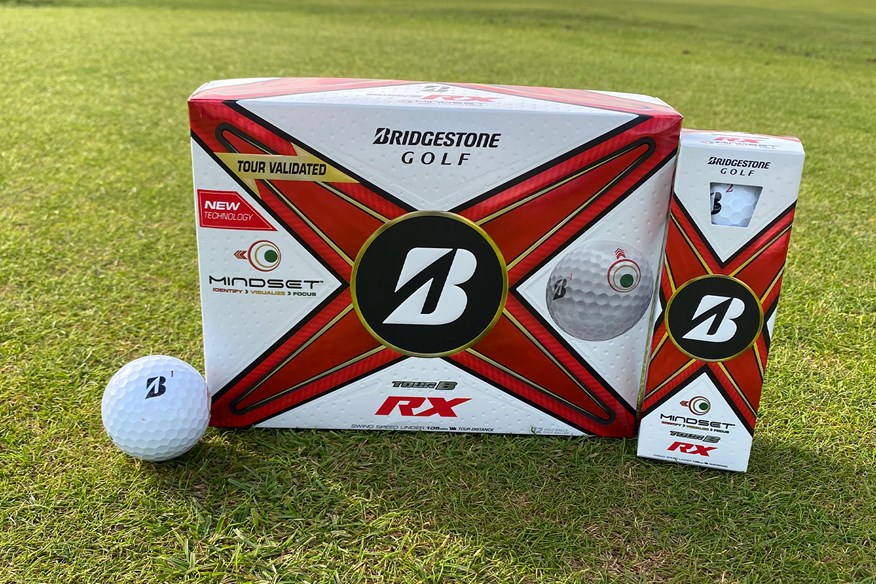

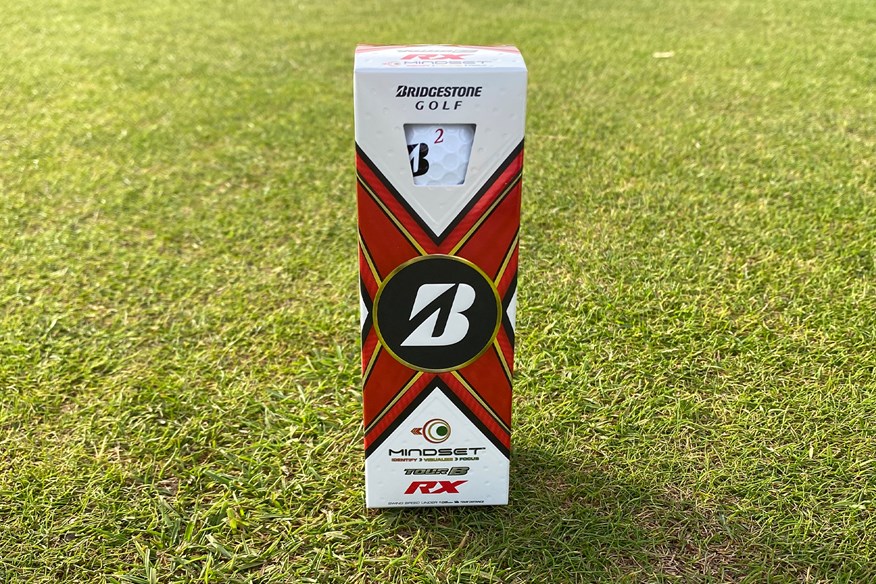

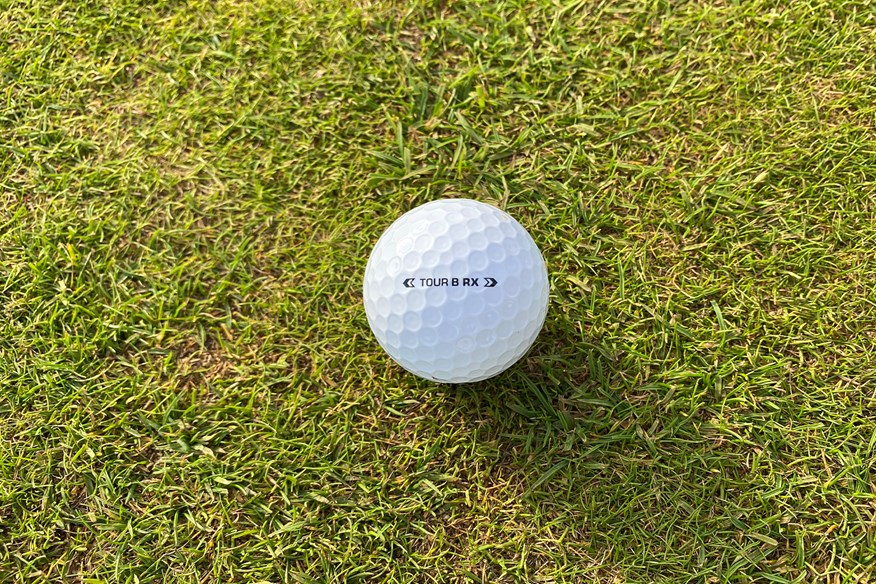

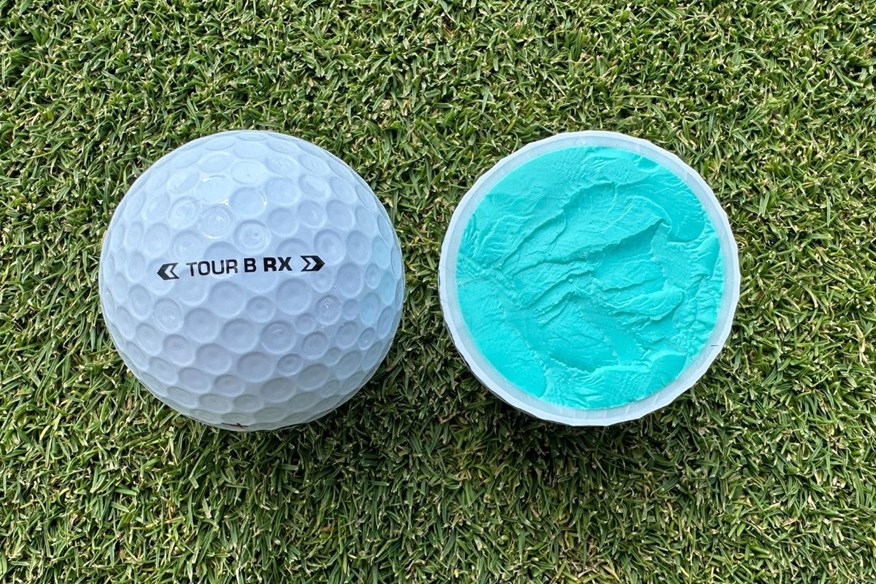
There isn't an awful lot to say about the Bridgestone Tour B RX golf ball other than out of the five three-piece Bridgestone golf balls, including the four members of the Tour B range, the Tour B RX is the longest golf ball, delivering 268.9 carry yards at the 114mph driver swing speed.
At 93mph and 78mph, the Tour B RX isn't as long as other three-piece club golfer models, nor is it as long as other three-piece Bridgestone golf balls. However, at both swing speeds, it is longer than the higher-spinning Tour B RXS.
Although the Tour B RX is sold as the more distance-oriented Tour B model for golfers who swing their driver below 95mph, it's not too far behind the Tour B RXS with regard to spin in approach play and short game performance. The Tour B RX generates 4,733rpm with the 7-iron and 5,645rpm with the 40-yard pitch shot. In both instances, it's within 100rpm of the higher-spinning Tour B RXS.
The Tour B RX is a solid golf ball, but it's not going to blow you away with its performance. You can expect all-around performance, with a slight emphasis on distance over spin.
On-course verdict
The Bridgestone Tour B RX isn't a golf ball I would consider playing with because it doesn't suit my game. For that reason, I trusted one of my playing partners to offer his verdict on this golf ball.
The Tour B RX is designed for golfers who swing their driver slower than 105mph and prioritize distance over spin. Thankfully, someone I regularly play golf with falls into that category.
He enjoyed the mindset technology most about this golf ball, which tells you how good that is, considering with this golf ball in play, he recorded two rounds of 75.
Distance was where he expected, and so was spin. He doesn't play with a lot of spin through choice, and this golf ball allowed him to continue chasing the ball up the fairway off the tee and towards the flag on the greens.
If you would benefit from more spin, depending on your swing speed, you'll want either the Tour B RXS or Tour B XS in play.
The Tour B RX is a model played on the Champions Tour but not on the PGA or DP World Tour, hence why it's more suited to club golfers with a swing speed south of 105mph.
If you're looking to maximize distance, the Tour B RX is a model well worth your consideration.
Read our full Bridgestone Tour B RX golf ball review.
Pros
- Competitive distance
- Impressive spin and control
- Delivers on its promise
Cons
- Not the most exciting golf ball
| Carry distance (yds) | Driver 114mph - 268.9 | Driver 93mph - 206.5 | Driver 78mph - 160.4 | 7-iron - 155.4 |
| Ball speed (mph) | Driver 114mph - 161.8 | Driver 93mph - 133.1 | Driver 78mph - 112.9 | 7-iron - 108.8 |
| Backspin (rpm) | Driver 114mph - 2,732 | Driver 93mph - 2,780 | Driver 78mph - 2,532 | 7-iron - 4,733 | Pitch - 5,645 |
| Launch angle (°) | Driver 114mph - 11.3 | Driver 93mph - 12.6 | Driver 78mph - 13.8 | 7-iron - 20.7 | Pitch - 30.9 |
| Descent angle (°) | Driver 114mph - 37.4 | Driver 93mph - 32.2 | Driver 78mph - 27.5 | 7-iron - 44.9 | Pitch - 36.4 |
| Peak height (yds) | Driver 114mph - 32.3 | Driver 93mph - 22 | Driver 78mph - 15.4 | 7-iron - 29.2 | Pitch - 7 |
| Compression (psi) | 99 |
- REACTIV X System
- REACTIV iQ Smart Cover Technology
- XCLRNT mid-layer
- Gradational Core
- Dual Dimple
- Seamless Cover
- 330 dimples
- 3-Piece construction
- Available in white and yellow
- An alternative model is the Mindset
The most redundant Bridgestone golf ball
Softest three-piece Bridgestone golf ball
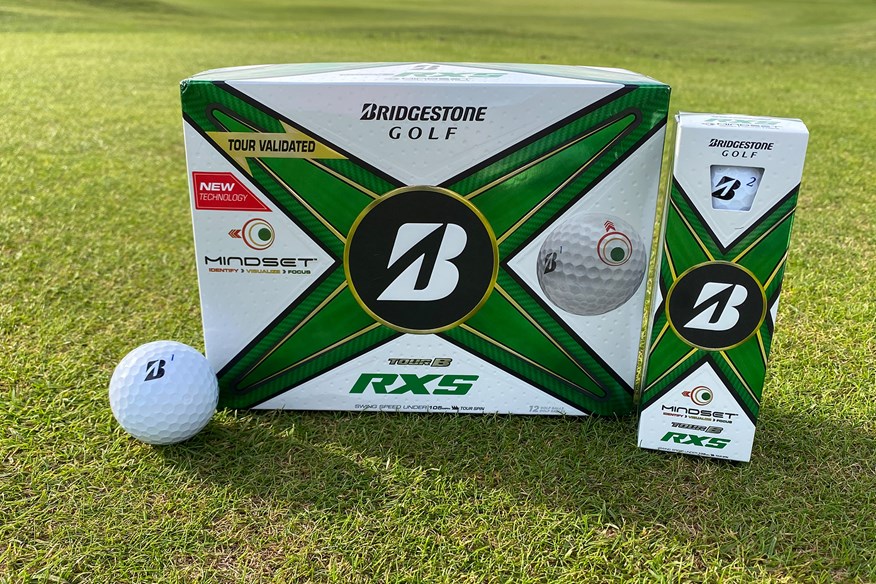

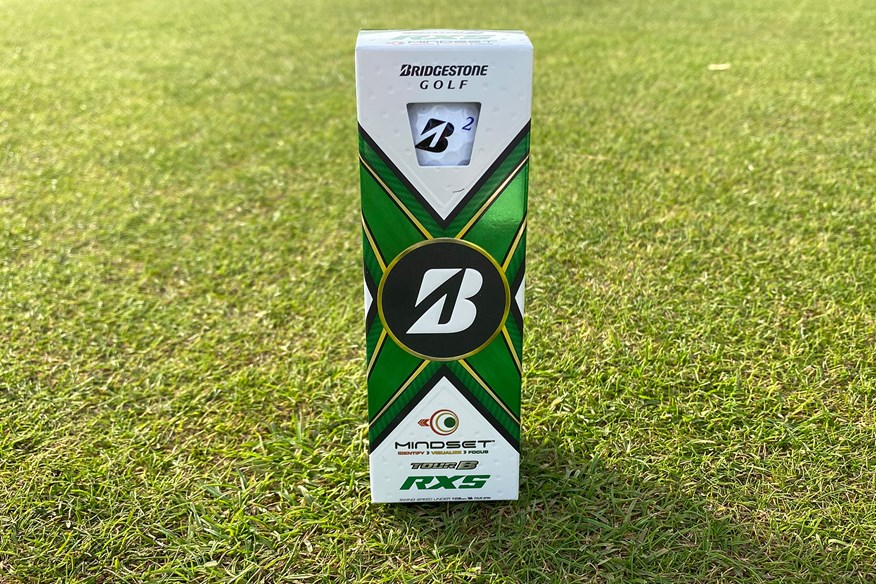
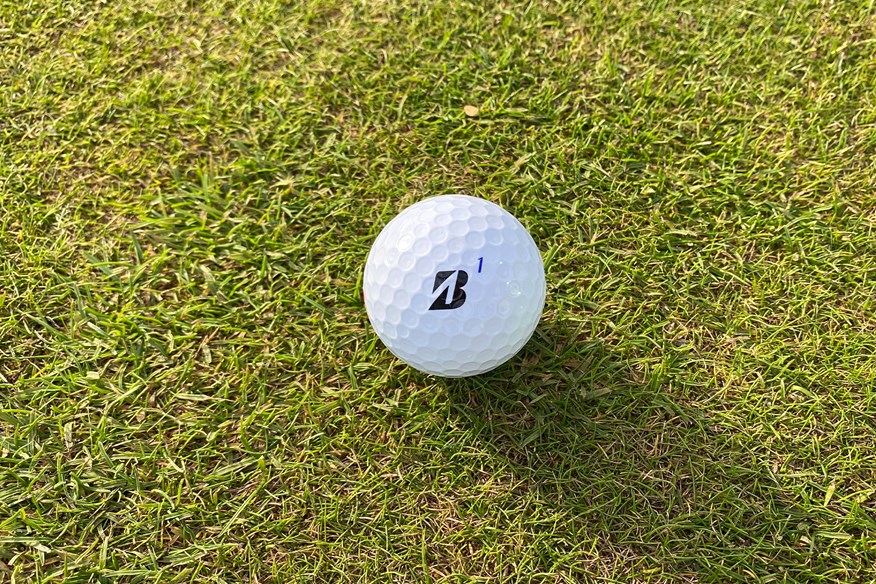

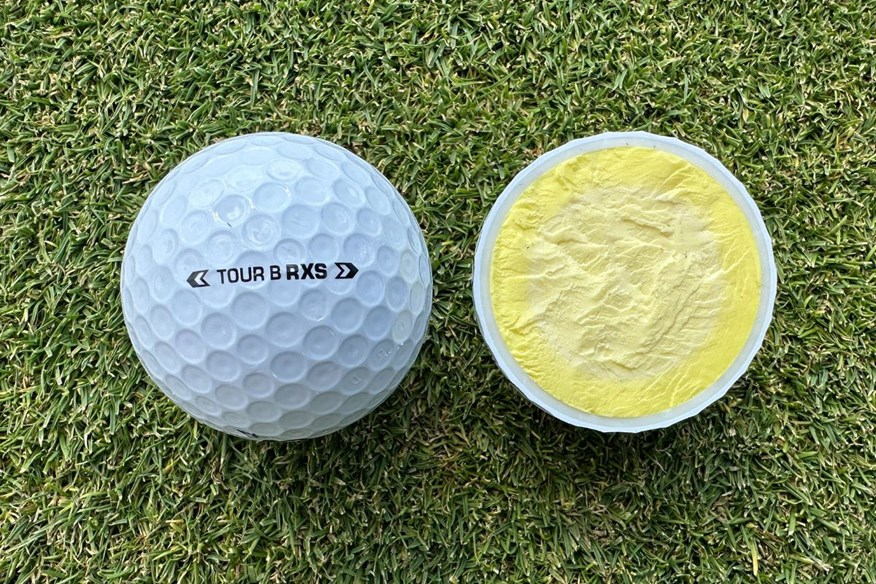
It might sound harsh, calling the Tour B RXS Bridgestone's most redundant golf ball, but I do have my reasons. The first reason is that it's the same price as the other three Tour B golf balls, and its performance is not as impressive.
Approaching and playing around the greens, being a high-spin golf ball for golfers with moderate and slow swing speeds, you'd expect more spin than 4,813rpm, which is the second-highest three-piece club golfer model with the 7-iron shot, but it's only 80rpm higher than the Tour B RX, which offers more distance.
Short game performance tells a very similar story. It's the fourth-highest-spinning model, but the Tour B RX is right behind it again, this time only 57rpm behind.
Off the tee, the Tour B RXS isn't as long as the Tour B RX, and for me, that's the biggest reason why I view this as a redundant golf ball. You're not getting much more spin, and you're getting less distance. If you're choosing between the Tour B RXS or Tour B RX, do what Freddie Couples did and choose Tour B RX.
On-course verdict
I'm not the intended golfer for the Bridgestone Tour B RXS, and although I do benefit from higher-spinning golf balls, I'm really not a fan of this model.
I asked one of my playing partners to try the Tour B RXS and the Tour B RX. His game would most likely suit the Tour B RXS, but he preferred the Tour B RX.
The RXS delivers high greenside spin and control and a very pleasant feel, but apart from that, there isn't really anything this golf ball offers that the other three Tour models don't.
Even if you have a slower swing speed, you should still be able to make the B X, B XS, or B RX work for you, and the RXS really is a last resort.
Read our full Bridgestone Tour B RXS golf ball review.
Pros
- Good soft feel in the short game
- High control and spin
- Nice soft feel off the putter face
Cons
- Doesn't perform too well for faster swing speeds
| Carry distance (yds) | Driver 114mph - 263.8 | Driver 93mph - 206.2 | Driver 78mph - 159.2 | 7-iron - 155.5 |
| Ball speed (mph) | Driver 114mph - 158.3 | Driver 93mph - 132.9 | Driver 78mph - 112.3 | 7-iron - 109.1 |
| Backspin (rpm) | Driver 114mph - 2,696 | Driver 93mph - 2,815 | Driver 78mph - 2,483 | 7-iron - 4,813 | Pitch - 5,702 |
| Launch angle (°) | Driver 114mph - 12.2 | Driver 93mph - 12.6 | Driver 78mph - 13.9 | 7-iron - 20.6 | Pitch - 30.9 |
| Descent angle (°) | Driver 114mph - 37.9 | Driver 93mph - 32.5 | Driver 78mph - 27.3 | 7-iron - 44.9 | Pitch - 36.6 |
| Peak height (yds) | Driver 114mph - 32.8 | Driver 93mph - 22.2 | Driver 78mph - 15.3 | 7-iron - 29.2 | Pitch - 7.2 |
| Compression (psi) | 81 |
- REACTIV X System
- REACTIV iQ Smart Cover Technology
- XCLRNT mid-layer
- Gradational Core
- Dual Dimple
- Seamless Cover
- 330 dimples
- 3-Piece construction
- Available in white and yellow
- An alternative model is the Mindset
Bridgestone's 3-piece golf ball in the e12 series
The Bridgestone e12 series comprises three golf balls, but the e12 Straight is the only three-piece model in the range. With that, you might expect this to be the best-performing model, but is that the case?
Sadly not. The e12 Straight performed consistently between the e12 Speed and e12 HiLaunch. There's not much to say about the e12 Straight's performance in this year's test because it was very middle-of-the-road.
In approach play and short game performance, this golf ball spins below the test average. Although off the tee, it performs close to the Tour B RXS.
Unless you need serious help straightening up your ball flight, I wouldn't jump to the e12 Straight.
On-course verdict
The low-spinning nature of the e12 Straight helps it to fly straight. That being said, it's not going to cure a wicked hook or slice if your swing path is off the richter.
The e12 Straight is the only three-piece golf ball in the e12 series, but does that make it the best option? I don't think so. I would recommend the e12 Speed over the e12 Straight.
I don't particularly like the feel of the e12 Straight. My opinion is that it's quite clicky and sticky. However, it is a durable cover, which adds to this golf ball's value.
Pros
- Straight flight technology does work
- Low-spinning off the tee
- Durable cover
Cons
- Worst performing three-piece Bridgestone golf ball in our 2025 robot test
| Carry distance (yds) | Driver 114mph - 267.5 | Driver 93mph - 206.8 | Driver 78mph - 159.2 | 7-iron - 158 |
| Ball speed (mph) | Driver 114mph - 160.9 | Driver 93mph - 132.9 | Driver 78mph - 112.3 | 7-iron - 108.7 |
| Backspin (rpm) | Driver 114mph - 2,677 | Driver 93mph - 2,642 | Driver 78mph - 2,352 | 7-iron - 4,240 | Pitch - 5,556 |
| Launch angle (°) | Driver 114mph - 11.4 | Driver 93mph - 12.8 | Driver 78mph - 14.1 | 7-iron - 21.5 | Pitch - 31.7 |
| Descent angle (°) | Driver 114mph - 36.9 | Driver 93mph - 31.8 | Driver 78mph - 27 | 7-iron - 44.7 | Pitch - 37.4 |
| Peak height (yds) | Driver 114mph - 31.7 | Driver 93mph - 21.9 | Driver 78mph - 15.2 | 7-iron - 29.7 | Pitch - 7.4 |
| Compression (psi) | 75 |
- Optimal Flight System
- Contact Force Dimple technology
- MindSet technology
- 326 dimples
- 3-Piece construction
- Available in white, green, and yellow
Bridgestone's cheapest golf ball
The e6 Soft Feel is described by Bridgestone as a soft-feeling, long-distance golf ball. Our robot can't comment on feel, but we are able to see this isn't a particularly long golf ball.
This golf ball is among the shorter two-piece models at all three driver swing speeds. The highest ranking achieved by the e6 Soft Feel is at 93mph, where it finished 53rd overall and 13th in this category.
Approach play performance is the area where the e6 Soft Feel performed best, but with an eight-place finish in the two-piece category (44th overall), it's not the most inspiring performance.
The e6 Soft Feel doesn't perform terribly around the green. Regarding short game performance, it spins below the test average (5,551rpm), but compared to other two-piece golf balls, it's 102rpm above average.
This might be Bridgestone's cheapest golf ball, and that does make it enticing, but I'd definitely recommend paying the extra and going for the e12 Speed.
On-course verdict
The e6 Soft Feel is a golf ball I actually quite enjoy playing with on-course. Reading the results of our 2025 robot test could completely deter you from trying this model, but maybe my on-course verdict can sway you.
I've also not found the e6 Soft Feel to deliver strong distance off the tee, but distance isn't what I look for in a golf ball. From the fairways and around the greens, I think this is a very well-behaved golf ball. It doesn't generate tons of spin, but it's easy enough to control.
I'm not super keen on the feel of this golf ball, but you can't criticize the durability of the cover at all.
This isn't as good as the e12 Speed, but no two-piece golf ball is. If you're not willing to budge on price, you can definitely do worse than the e6 Soft Feel.
Pros
- Inexpensive and good-quality
- Better value than other Bridgestone golf balls
- Good durability
Cons
- Not particularly strong distance
| Carry distance (yds) | Driver 114mph - 265.8 | Driver 93mph - 204.6 | Driver 78mph - 155.7 | 7-iron - 156.2 |
| Ball speed (mph) | Driver 114mph - 159.4 | Driver 93mph - 132 | Driver 78mph - 110.7 | 7-iron - 108.4 |
| Backspin (rpm) | Driver 114mph - 2,519 | Driver 93mph - 2,528 | Driver 78mph - 2,210 | 7-iron - 4,454 | Pitch - 5,551 |
| Launch angle (°) | Driver 114mph - 11.8 | Driver 93mph - 13 | Driver 78mph - 14.4 | 7-iron - 21.2 | Pitch - 31.6 |
| Descent angle (°) | Driver 114mph - 36.1 | Driver 93mph - 31.1 | Driver 78mph - 26.5 | 7-iron - 44.8 | Pitch - 37.5 |
| Peak height (yds) | Driver 114mph - 30.9 | Driver 93mph - 21.3 | Driver 78mph - 15.1 | 7-iron - 29.3 | Pitch - 7.6 |
| Compression (psi) | 45 |
- Gradational compression
- Seamless Cover Technology
- Softer and larger core
- 330 dimples
- 2-Piece construction
- Available in white and yellow
Bridgestone's highest-launching golf ball
Given how impressive the Bridgestone e12 Speed is, it's very difficult to recommend the e12 HiLaunch. The only time I would suggest this golf ball to anyone is if you seriously struggle getting the ball in the air.
The e12 HiLaunch is Bridgestone's highest-launching golf ball in every area and at every driver swing speed, barring 114mph, but this golf ball isn't designed to be played by golfers who swing like a Tour pro.
It's not drastically higher-launching than other Bridgestone golf balls, and it's not particularly high-launching compared to other brands' offerings. However, if you want to play Bridgestone and you feel as though an extra bit of launch will help you, the e12 HiLaunch must come into question.
That being said, you should be able to make the e12 Speed work, and the benefits are huge if you can.
On-course verdict
I was left very confused by the e12 HiLuanch when I tested it on the golf course because I wasn't quite expecting this model to launch as high as it did.
With my mini driver, the e12 HiLaunch was launching roughly 2° higher than the e12 Straight and 4° higher than the e12 Speed. However, the spin wasn't particularly higher. Spin was actually relatively similar.
From 150 yards and in, I really enjoyed the HiLaunch because it canoned into the air and stopped very quickly. For that reason, I'm very surprised to see it's the lowest-spinning Bridgestone golf ball.
On-course, I was expecting this golf ball to fly high and not deliver any distance or spin. I was pleasantly surprised. I wouldn't game this model over the e12 Speed, but in the e12 series, I'd rank this ahead of the e12 Straight.
Pros
- Delivers on its HiLaunch pledge
- Positive impression on-course
- Durable cover
Cons
- Didn't perform in our 2025 robot test
| Carry distance (yds) | Driver 114mph - 265.7 | Driver 93mph - 204.6 | Driver 78mph - 158.7 | 7-iron - 157 |
| Ball speed (mph) | Driver 114mph - 159.3 | Driver 93mph - 131.8 | Driver 78mph - 111.9 | 7-iron - 108.1 |
| Backspin (rpm) | Driver 114mph - 2,451 | Driver 93mph - 2,518 | Driver 78mph - 2,200 | 7-iron - 4,206 | Pitch - 5,437 |
| Launch angle (°) | Driver 114mph - 11.7 | Driver 93mph - 13.1 | Driver 78mph - 14.5 | 7-iron - 21.7 | Pitch - 32 |
| Descent angle (°) | Driver 114mph - 35.5 | Driver 93mph - 31.2 | Driver 78mph - 26.8 | 7-iron - 44.6 | Pitch - 38 |
| Peak height (yds) | Driver 114mph - 30.4 | Driver 93mph - 21.4 | Driver 78mph - 15.2 | 7-iron - 29.5 | Pitch - 7.7 |
| Compression (psi) | 43 |
- Optimal Flight System
- Low compression soft core
- MindSet technology
- 330 dimples
- 2-Piece construction
- Available in white only
Best Bridgestone golf balls 2025: Robot test data
| Golf ball | Bridgestone e12 Speed | Bridgestone Tour B XS | Bridgestone Tour B X | Bridgestone Tour B RX | Bridgestone Tour B RXS | Bridgestone e12 Straight | Bridgestone e6 Soft Feel | Bridgestone e12 HiLaunch |
| Compression | 103 | 99 | 112 | 99 | 81 | 75 | 45 | 43 |
| 114mph Driver Ball Speed (mph) | 164 | 162.7 | 160.4 | 161.8 | 158.3 | 160.9 | 159.4 | 159.3 |
| 114mph Driver Launch Angle (°) | 11.4 | 11.0 | 12.1 | 11.3 | 12.2 | 11.4 | 11.8 | 11.7 |
| 114mph Driver Backspin (rpm) | 2680 | 2964 | 2605 | 2732 | 2696 | 2677 | 2519 | 2451 |
| 114mph Driver Carry Distance (yds) | 273.9 | 268.4 | 268.3 | 268.9 | 263.8 | 267.5 | 265.8 | 265.7 |
| 114mph Driver Height (yds) | 33 | 33.1 | 32.8 | 32.3 | 32.8 | 31.7 | 30.9 | 30.4 |
| 114mph Driver Descent Angle (°) | 37.6 | 38.6 | 37.5 | 37.4 | 37.9 | 36.9 | 36.1 | 35.5 |
| 93mph Driver Ball Speed (mph) | 134.1 | 133.6 | 134.0 | 133.1 | 132.9 | 132.9 | 132.0 | 131.8 |
| 93mph Driver Launch Angle (°) | 12.9 | 12.3 | 12.7 | 12.6 | 12.6 | 12.8 | 13.0 | 13.1 |
| 93mph Driver Backspin (rpm) | 2574 | 3059 | 2810 | 2780 | 2815 | 2642 | 2528 | 2518 |
| 93mph Driver Carry Distance (yds) | 209.7 | 206.7 | 208.7 | 206.5 | 206.2 | 206.8 | 204.6 | 204.6 |
| 93mph Driver Height (yds) | 22.3 | 22.8 | 22.7 | 22.0 | 22.2 | 21.9 | 21.3 | 21.4 |
| 93mph Driver Descent Angle (°) | 31.8 | 33.6 | 32.8 | 32.2 | 32.5 | 31.8 | 31.1 | 31.2 |
| 78mph Driver Ball Speed (mph) | 113.2 | 112.8 | 112.8 | 112.9 | 112.3 | 112.3 | 111.7 | 111.9 |
| 78mph Driver Launch Angle (°) | 14.1 | 13.7 | 13.9 | 13.8 | 13.9 | 14.1 | 14.4 | 14.5 |
| 78mph Driver Backspin (rpm) | 2317 | 2795 | 2512 | 2532 | 2483 | 2352 | 2190 | 2200 |
| 78mph Driver Carry Distance (yds) | 161.3 | 160.5 | 160.5 | 160.4 | 159.2 | 159.2 | 158.1 | 158.7 |
| 78mph Driver Height (yds) | 15.5 | 15.8 | 15.5 | 15.4 | 15.3 | 15.2 | 15.1 | 15.2 |
| 78mph Driver Descent Angle (°) | 27 | 28.4 | 27.5 | 27.5 | 27.3 | 27.0 | 26.6 | 26.8 |
| 7-Iron Ball Speed (mph) | 109.2 | 109.0 | 108.9 | 108.8 | 109.1 | 108.7 | 108.4 | 108.1 |
| 7-Iron Launch Angle (°) | 21.3 | 20.3 | 20.8 | 20.7 | 20.6 | 21.5 | 21.2 | 21.7 |
| 7-Iron Backspin (rpm) | 4467 | 5170 | 4787 | 4733 | 4813 | 4240 | 4454 | 4206 |
| 7-Iron Carry Distance (yds) | 157.6 | 153.5 | 155.2 | 155.4 | 155.5 | 158.0 | 156.2 | 157.0 |
| 7-Iron Height (yds) | 30 | 29.1 | 29.4 | 29.2 | 29.2 | 29.7 | 29.3 | 29.5 |
| 7-Iron Descent Angle (°) | 45.1 | 45.2 | 45.1 | 44.9 | 44.9 | 44.7 | 44.8 | 44.6 |
| 40-Yard Pitch Ball Speed (mph) | 46.4 | 46.7 | 46.2 | 46.5 | 46.9 | 46.7 | 47.3 | 47.1 |
| 40-Yard Pitch Launch Angle (°) | 30.7 | 30.0 | 30.3 | 30.9 | 30.9 | 31.7 | 31.6 | 32.0 |
| 40-Yard Pitch Backspin (rpm) | 5951 | 6036 | 5972 | 5645 | 5702 | 5556 | 5551 | 5437 |
| 40-Yard Pitch Carry Distance (yds) | 39.8 | 40.0 | 39.4 | 40.1 | 40.9 | 40.9 | 41.8 | 41.7 |
| 40-Yard Pitch Height (yds) | 6.9 | 6.7 | 6.6 | 7.0 | 7.2 | 7.4 | 7.6 | 7.7 |
| 40-Yard Pitch Descent Angle (°) | 36 | 35.3 | 35.5 | 36.4 | 36.6 | 37.4 | 37.5 | 38.0 |
Best Bridgestone golf balls 2025: Buying guide
Bridgestone are one of the greatest manufacturers of golf balls. They produce a wide range of golf balls to accommodate the needs and wants of every golfer. The difficulty you’ll have is deciding which golf ball of theirs you should choose. To help you pick, I’ve put together a few considerations you should make to help you select the correct Bridgestone golf ball for your game.
Ability
Regardless of your ability, you will benefit from playing with the Bridgestone e12 Speed. Even though it’s a two-piece golf ball, it’s one of the best value golf balls, and the best Bridgestone golf ball. Most Bridgestone golf balls are versatile enough to present themselves as a solid option to the majority of golfers.
Better and more seasoned golfers arguably should be playing with the best balls they can afford to be playing with because it will 100 percent improve your game from tee to green. The flip side to that is, if you’re new to the game or play infrequently with your buddies, work colleagues, or whoever, then you might not have the game to warrant playing with premium golf balls for whatever reason. At that point, playing with cheap golf balls is perfectly understandable.
That being said, switching to one of the best value golf balls could help you play better golf and find more enjoyment – even if you do just play for fun.
Budget
Tied closely with ability is budget. Thankfully, the best Bridgestone golf ball is very reasonably priced, but if you do want to stretch for a member of the Tour B family – specifically the Tour B X or Tour B XS – they are among the more affordable premium golf balls.
Players who are new to the game or don’t get out often are more likely to budget when it comes to purchasing golf balls. Whereas more frequent and skilled golfers are less likely to budget and opt for more expensive golf balls. That’s not to say every golfer meeting one of those credentials behaves this way.
While I’ve probably been alive less number of years than some of you have played golf, I’ve had the pleasure of working in the golf industry for the entirety of my working life. During that time, I’ve seen golfers of all abilities splashing the cash on the latest golf clubs in the hope of improving their game and being thrifty when it comes to spending on golf balls – I’ve been a culprit of this myself in my early golfing days!
With the e12 Speed being the best overall Bridgestone golf ball, you probably can afford to save some cash if you’re shopping in the Bridgestone market, but with any brand, it’s not likely to be the case.
If there’s ever a piece of golf equipment you shouldn’t be frugal with, it’s golf balls!
Feel
The vast majority of golfers look for soft-feeling golf balls, which doesn’t really rule out any Bridgestone model. Even golf balls labeled as being firm, such as the Bridgestone Tour B X, is still soft compared to the rocks that used to exist. Many golfers enjoy soft-feeling golf balls because they deliver a sweet sensation off of every club in the bag – except if you skull one.
I enjoy playing with firmer golf balls – like the Tour B X – because I feel as though they provide more feedback and a stronger response. However, feel is completely personal, and like I say, it’s tough to find a super-firm golf ball because most are made to be soft to please the needs of more golfers.
Performance
Every Bridgestone golf ball comes fitted with specific technology in order to perform in a particular manner – this is often outlined on the box. For instance, it might inform you that a certain model is designed to travel high and far off the tee with low spin but grab and spin on the greens. Another golf ball might say it produces low flight off the tee and mid-spin in the short game.
Bridgestone offers golf balls for every golfer’s needs; whether you’re looking for a high-spinning, high-launching, soft, firm, or fast golf ball, Bridgestone has you covered.
To save you from working out which model you think is right for you. We have the answer. We’ve carried out a mammoth robot test to help you see how well a ball stacks up to the claims made by the manufacturer.
Spin
Ideally, every golf ball would produce low-spin off the tee and high-spin in your approach game. However, not all golf balls are designed that way. The majority of golf balls are designed to produce low driver spin and generate distance off the tee, but not all golf balls are manufactured to generate high spin from irons and wedges.
Price generally correlates with short-game spin. Budget golf balls will generate less short-game spin than expensive golf balls, but there might not be much difference in your long-game spin. During a ball fitting at Titleist, I discovered that a Titleist Pro V1x and Titleist Velocity performed very similarly with my driver, but with a 7-iron, the spin dropped slightly with the Velocity, and then with a 60° wedge, the spin fell massively with the Velocity.
Spin in the golf ball comes from the combination of layers within the golf ball reacting with one another, hence why more expensive golf balls spin more in approach play because they consist of more layers and the technology is more refined. Cheaper golf balls tend to consist of two layers: the cover and core. Therefore, they don’t have the number of layers required to produce astronomical spin when attacking pins.
Another factor that helps to enhance spin is the cover material. Golf balls with a urethane cover tend to spin more (but not always) because it’s a more flexible material compared to ionomer or surlyn, which doesn’t create as much friction with the clubface as urethane does. Once again, it’s more expensive golf balls that feature urethane covers to generate higher spin on approach shots.
Spin is massively important because it can either make you hit and hold a green or hit and fly over the green. The best golf balls for spin are by far premium golf balls, closely followed by golf balls for mid-handicappers, because they feature much of the technology found in Tour-standard golf balls. If you feel as though you need high levels of spin when attacking greens, have a look at the best high-spin golf balls. Alternatively, if you feel as though spin is hurting your game, check out the best low-spin golf balls.
Distance
I would honestly say that distance is the last factor to consider when purchasing golf balls. The best way to figure out which golf balls are best for you is by working your way back from the green to the tee box. The best way of doing this is with a launch monitor to see your numbers, but if you don’t have access to one, you can do it with your eye very easily.
Start by hitting wedge shots into the green and see which balls are performing best with spin, then work your way back to 7-iron distance and look for the same numbers with slightly more of an eye on carry distance. You should have whittled it down to one or two golf balls, hit them off the tee, and look at which performs the best.
If you do it this way, I guarantee a premium golf ball will always come out on top if you’re testing one. However, if you’re doing this with cheaper golf balls, you’ll still see differences between the golf balls, and you will find one that performs well for you, or you might have the luxury of deciding between a handful.
By testing golf balls this way, you’ll end up with the ball that performs best in the short game, which is where you score. Distance is important, but there are other ways of improving distance without sacrificing spin in a golf ball.
Color
The most common golf ball color is white; however, there are plenty of other colors and designs to choose from. More vibrant colors, such as yellow, orange, or green, are all easy to pick up, and they help some people with visibility – hence why they make for the best winter golf balls.
Other ways of adding color to the golf ball can be by design, whether it be a splash of color seen on Vice golf balls or an alignment design which also helps with visibility, such as TaylorMade’s Pix golf balls or Callaway’s Triple Track golf balls.
If you’ve only ever played with white golf balls, it might be worth trying a more colorful golf ball, especially if you’re always the one asking your playing partners, “Where did that one go?”.
Alignment
More and more golf balls are being released with enhanced alignment, and even standard golf balls have a more prominent alignment stamp now than they’ve ever had. The majority of brands now offer golf balls with enhanced alignment aids. The enhanced alignment aids can be extremely useful for putting and even lining up shots on the tee. Another plus of alignment golf balls is the alignment serves as a tool for finding your golf ball either in the air or among the trees.
Best Bridgestone golf balls 2025: FAQs
What to read next
For performance insights tailored to your swing speed and preferences, head to our results hubs:
- Best 4 and 5-piece golf balls
- Best 3-piece golf balls
- Best 2-piece golf balls
- Best golf balls for fast swing speeds
- Best golf balls for average swing speeds
- Best golf balls for slow swing speeds
- Best golf balls for distance
- Best golf balls for approach play
- Best golf balls for mid-handicaps
- Best golf balls for beginners
- Most consistent golf balls
-
 Best Bridgestone golf balls 2025
Best Bridgestone golf balls 2025
-
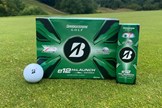 Bridgestone e12 HiLaunch golf balls
Bridgestone e12 HiLaunch golf balls
-
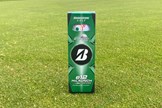 Bridgestone e12 HiLaunch golf balls
Bridgestone e12 HiLaunch golf balls
-
 Bridgestone e12 HiLaunch golf ball
Bridgestone e12 HiLaunch golf ball
-
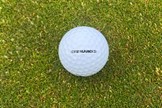 Bridgestone e12 HiLaunch golf ball
Bridgestone e12 HiLaunch golf ball
-
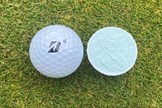 Bridgestone e12 HiLaunch golf ball cut through
Bridgestone e12 HiLaunch golf ball cut through
-
 Bridgestone e12 Straight golf balls
Bridgestone e12 Straight golf balls
-
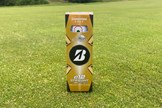 Bridgestone e12 Straight golf balls
Bridgestone e12 Straight golf balls
-
 Bridgestone e12 Straight golf ball
Bridgestone e12 Straight golf ball
-
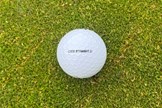 Bridgestone e12 Straight golf ball
Bridgestone e12 Straight golf ball
-
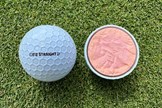 Bridgestone e12 Straight golf ball cut through
Bridgestone e12 Straight golf ball cut through
-
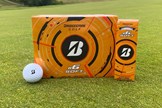 Bridgestone e6 Soft Feel golf balls
Bridgestone e6 Soft Feel golf balls
-
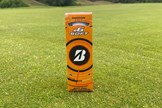 Bridgestone e6 Soft Feel golf balls
Bridgestone e6 Soft Feel golf balls
-
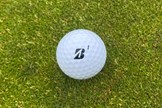 Bridgestone e6 Soft Feel golf ball
Bridgestone e6 Soft Feel golf ball
-
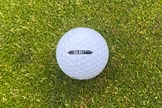 Bridgestone e6 Soft Feel golf ball
Bridgestone e6 Soft Feel golf ball
-
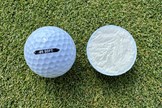 Bridgestone e6 Soft Feel golf ball cut through
Bridgestone e6 Soft Feel golf ball cut through
-
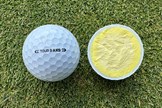 A cut through of the Bridgestone Tour B RXS golf ball
A cut through of the Bridgestone Tour B RXS golf ball
-
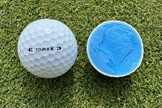 A cut through of the Bridgestone Tour B X golf ball
A cut through of the Bridgestone Tour B X golf ball
